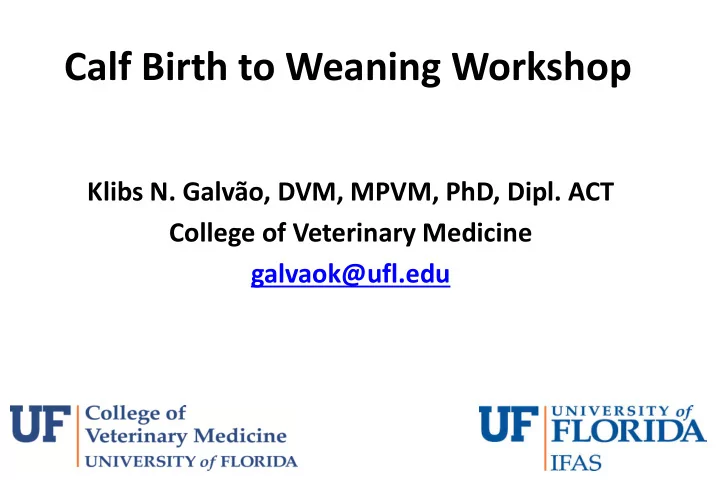

Calf Birth to Weaning Workshop Klibs N. Galvão, DVM, MPVM, PhD, Dipl. ACT College of Veterinary Medicine galvaok@ufl.edu
Objectives of Raising Dairy Heifers Live calf at birth (< 5% stillbirths) Minimize morbidity (<25% from birth to weaning) Minimize mortality (< 5% from birth to weaning) Double birth weight until weaning; 180 lbs Start breeding at 14 months; 55% of mature weight; 800 lbs Pregnant at 15 months Calve at 24 months of age; 82% of mature weight; 1230 lbs Result in a lactating cow of high potential for production
Target weights
How can we achieve those goals? • Colostrum & Feeding management • Housing • Hygiene • Fly control • Others • Establish SOP for each step
Colostrum • Colostrum is the milk from the first milking only!!
Colostrum • Timing • Quality • Quantity • Conservation • Testing
Colostrum • Quantity, quality and timing – 0.75 to 1 gal of good quality colostrum in the first 6 h of life. 1-2 h is ideal . < 20,000 cfu ≥ 22%
Colostrum Management - Time Efficiency of Ig Absorption (%) Efficiency of absorption is ~30% at birth Gut closure occurs in a linear fashion beginning at birth Closure complete by 24 h Birth 12 hr 24 hr
Colostrum Conservation (to control bacterial contamination) Ambient Temp (feed it now!!!) Refrigerated (2 d to 1 wk.), preservatives: potassium sorbate 0.5% final solution Frozen (up to 1 yr)
Colostrum Pasteurization (60°C/60 min) Raw colostrum → source of infection of Mycoplasma, Mycobacterium, E. coli, Salmonella and more . Johnson & Godden, 2007: Feed at 1-2 hs of age Did not affect IgG concentration Decreased bacterial contamination Increased IgG concentration in serum (24hs) Increased efficiency of absorption (35.6% vs 26.1% raw colostrum)
Colostrum-derived CR • Feed 2 doses
Assessing Colostrum Management On-Farm • Refractometer - $30-500 on Ebay or Amazon • TP ≥ 5.5 mg/dl – adequate • TP = 5.0 to 5.4 mg/dl – marginal • TP < 5.0 mg/dl – fail
Assessing Colostrum Management On-Farm • Refractometer - $30-500 on Ebay or Amazon • Brix% ≥ 8.6 – adequate • Brix% = 8.0 to 8.5 – marginal • Brix% < 8.0 – fail
Survival Time Preweaning for Calves According to Serum IgG (n = 871 in 4 dairies) 100 95 Proportion surviving 90 85 Effect of serum IgG on survival time: P < 0.01 < 1,000 mg/dL 80 1,000 - 1,500 mg/dL > 1000 mg/dL 1,500 mg/dL 75 0 10 20 30 40 50 60 70 80 Age, d Santos et al. (2008)
Milk & Milk Replacers
Milk Feeding Period (1d to ~8 wks) • Fresh salable or non-salable pasteurized milk or high quality milk replacer • Feed twice a day or more to reduce digestive disturbance • Feed out of an open-faced bucket, not a nipple bottle or nipple pail because nipples are hard to clean • Observe calves at least twice a day for evidence of disease (diarrhea, septicemia, pneumonia)
Milk Feeding Period • Traditionally 2 qts 2 X/d. Calves may drink up to 3.7 gal/d • Many farms are adopting ad libitum milk feeding Week 1&2 Weeks 3-6 Week 7 Week 8 Week 9 1 gal 2X 1.5 gal 2X 1.5 gal 1X Grain only Wean
Housing • Calves are housed individually or in groups for the first 8-10 wks of age. • Ad libitum feeding is more easily implemented with group housing.
Housing • Heifers stay in group pens until calving
Introduction Three important points for herd size growth: • Good reproduction • Low cow mortality and culling • Good replacer heifer management Reference: Dairy Cattle Health and Management Practices in the United States, 2007
Morbidity and Mortality Range between 8% and 11%. • Scours, diarrhea, or other digestive problems accounted for the highest percentage of unweaned heifer deaths (60.5 percent). USDA 2007. • Diarrhea and respiratory problems account for 85% of the deaths in unweaned calves.
Calf Diarrhea • Diarrhea can occur at any age • Most common in the pre-weaning period of life • Can be caused by different types of organisms
Diarrhea Etiology • Viral - Rota Virus - Corona Virus • Bacterial - Escherichia coli - Zoonotic - Salmonella - Zoonotic - Clostridium • Protozoa - Cryptosporidia - Zoonotic - Coccidia
Prevention of Diarrhea • Proper nutrition program – Undernutrition is the major cause of high prevalence of disease in calves • Sanitation and basic measures of biosecurity – Sanitation of environment and equipment, grouping of animals, and elimination of potential fomites • Proper housing – Clean • Vaccination programs – Vaccination of the dam (Corona and Rota viruses) to confer immunity through colostrums
Treatment of Diarrhea • Dehydration is what kills the calf – Skin "tents", mouth isn’t slick, eyes are sunk • Broad-spectrum antibiotics • Continue to feed milk • Rehydration with electrolyte feeding instead of water – Skin tents for 4-5 sec and calf drinks from a bottle, feed 1 bottle of electrolyte 2- 3 times a day between milk feedings; otherwise use stomach tube – Skin tents for > 5sec, IV fluids (3-4 qts) 2-3 times a day is required
Respiratory Diseases • Affects calves of all ages, but it peaks in the first two weeks after weaning • Common agents – Viruses = bovine respiratory syncitial virus (BRSV), infectious bovine rinotracheitis virus (IBR), bovine viral diarrhea virus (BVD) – Bacteria = Mannheimia haemolytica , Pasteurella multocida , Histophylus somni , and Mycoplasma spp.
Respiratory Diseases
Prevention of Pneumonia • Proper nutrition program – Undernutrition the major cause of high prevalence of disease in calves • Sanitation and basic measures of biosecurity – Grouping of animals, sanitation, elimination of potential fomites • Proper housing – Ventilation • Vaccination programs – Critical for respiratory diseases (DVD,BRSV, IBR, PI3)
Vaccination, DRU SOP
Treatment of Pneumonia • Antibiotics • Anti-inflammatories/antipiretics
Questions??
Recommend
More recommend